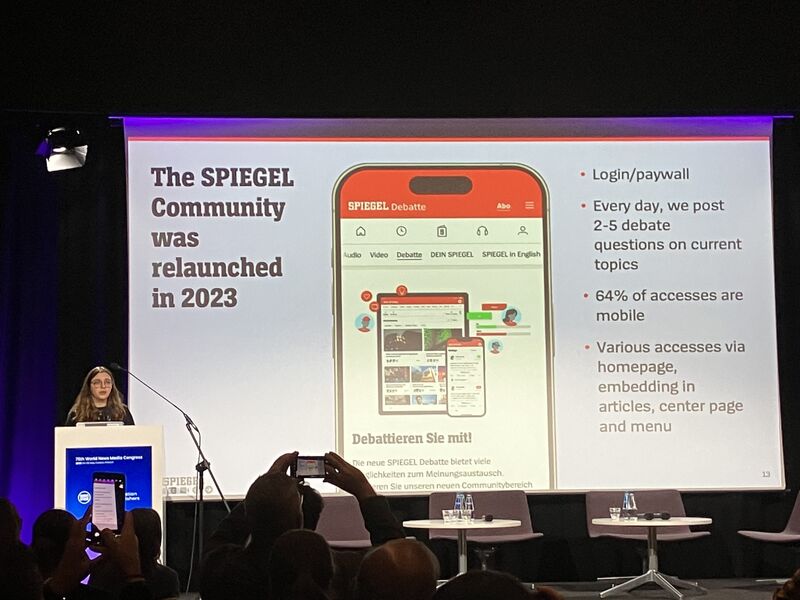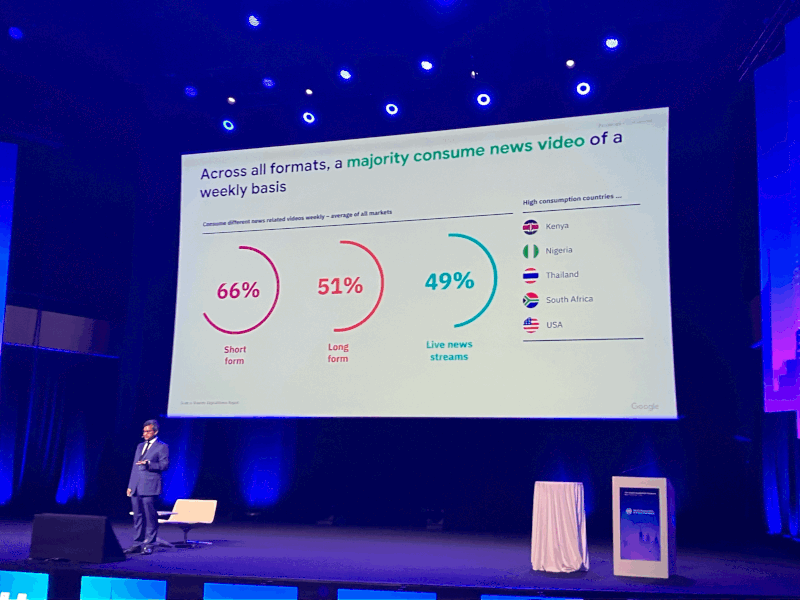Last week, I attended WAN-IFRA’s World News Media Congress in Kraków. With streams for media leaders, editors, digital media, and topical deep dives on specific issues often running concurrently, it’s impossible to take it all in, especially when there are so many interesting side conversations to be had. I focused on the digital media track, and it covered many of the current major digital themes in journalism: community (including young audience engagement), reader revenue, and AI. This week and next week, I’ll be highlighting some of the sessions from the Congress that resonated with me.
Community and sparking more participation at the FT
The rising importance of reader revenue and the decline in referrals from social and search have led publishers to deepen their relationships with their audiences. Hannah Sarney, editorial product director and executive editor at the Financial Times, talked of how they were updating their commenting community. Owned spaces result in deeper trust, she said.
While most publishers shut down their comment sections as audiences shifted to social platforms a decade ago, the FT kept theirs. Comment readers are 11x more engaged than active users who don’t read comments, and comment writers are 48x more engaged. “Community isn’t a bolt-on,” she said. The challenge is to get more readers engaged in the community. Only about half of the audience read the comments, and only 4% wrote comments.
“That leaves quite a bit of a gap,” she admitted, but she argues that this isn’t down to apathy or because the audience doesn’t care. “They don’t feel that the door is open or that the door even exists.”
Hannah and I had some great conversations about product management in Perugia and Kraków, and I appreciate two things about her approach. When I was doing my master’s research, I found that successful product management was built on strong cross-functional relationships, and this is Hannah’s superpower, her ability to foster relationships across the business. The other reason why she is such a good product leader is that she is able to translate values and goals into a product. For their community, the FT wanted to:
spark participation
protect civility
foster togetherness.
Based on these goals, they are now testing a few approaches.
To support their moderation team, they have brought in an AI moderation tool from Utopia. “ It really has the human in the loop. It retrains off of the choices moderators make,” she said.
Their user research has shown that a sizeable chunk of their audience isn’t even aware the comments exist on the site. To overcome this, they have a new AI-powered tool that generates questions from articles to prompt engagement in the comments. Editors are given choices for the question, and they can choose the one that is the most appropriate for the story.
They are developing* and redesigning their live reader Q&A feature to drive broader participation and deliver a mobile-first user experience, clearly defined roles and the ability to easily catch up after the event is over.
How The City Connects with New York City Communities
Publishers have been struggling to reach new audiences with the decline in referrals from search and social media, but these platforms also don’t reach everyone. As I’ve written before, the Platform Era was an aberration, providing free marketing and audience growth. However, the cost was high. The platforms owned the audiences, and publishers only rented them.
I remember when I first came across the story of how The City creatively did audience development by using postal targeting available in the US in a Nieman Lab article. Nic Dawes, the executive director of The City, told the Congress how they used this technique to reach new audiences, especially those most affected by the stories they were covering. For instance, they did a story about landlords who didn’t heat their apartments, literally leaving their tenants in the cold. They used call data to find zip (postal) codes that had the highest density of heating complaints, and then they used the US Postal Service marketing programme to send postcards to people in areas most affected. Brilliant.
When they first started doing this, they tested the postal outreach against Facebook ads. Readers who received the postcards were not only more likely to read the stories, but they also spent more time with the stories. They have used this technique to target audiences near Superfund sites, highly toxic sites that are being cleaned up.
The other thing I love about their approach is that when they survey audiences, they don’t ask readers whether they liked the piece but “what the journalism helped them do”. Steal this idea.
And this was just one of the sessions. Here are a couple of the LinkedIn posts I wrote about others.
How Der Spiegel reworked its puzzles and comments to drive engagement
#wnmc25 | Kevin Anderson, FRSA
One of the major themes of WAN-IFRA's World News Media Congress 2025 is how publishers deepen relationships with audiences through high-engagement products and features. Dr. Laura Badura, product manager at Der Spiegel, spoke about two products the news publisher has created that have fostered civil civic debates and increased engaged audiences. Their strategy also demonstrates how they use different engagement products across their subscription funnel to engage, convert and retain subscribers. 🧩 Puzzles - With the New York Times and Wordle and even LinkedIn rolling them out, puzzles are a proven engagement product. • Use is high. On average, 900,000 users play Der Spiegel's daily news quiz every month. • Their morning newsletter is one of the major drivers of puzzle use, and the link to puzzles in the newsletter is the most clicked, which explains why mornings are the most popular time to play amongst users. •Der Spiegel's puzzles are free to play, setting it up as a tool to build habits that lead users to buy a subscription. 💬 From comments to debate - Der Spiegel has long had comments on its articles, Dr Badura said. Conversations were fragmented across articles on its previous commenting system. At its peak, they had 1.7 m comments a month, which presented a moderation challenge and led to fragmented conversations for users. • When trying to decide how to make commenting better, they started with audience research. Did the audience want community? Yes. They liked comments, but only 12% wanted to actively participate by posting a comment. However, 65% wanted to passively take part, by reading comments or listening to events. • Der Spiegel wanted to reduce the number of comments to make them more manageable. • When they relaunched the platform a year and a half ago, they had 10,000 registrations in the first seven hours and now have 350,000 registered users. • Instead of comments on all posts, they have 2-5 debates daily. The debates start with a yes or no question that allows users who want to passively engage. Comments are then added to each position, and comments can be upvoted. • They have hosted 1350 debates, which have received 5 million votes. The acceptance rate of comments has increased, and they now receive a more manageable 300,000 comments a month. • Users who use the product have more pageviews, and users who comment have almost 2x the time on site than those who don't. • The platform is connected to their subscription journey. • Unlike puzzles that are free to use, only subscribers can comment. • Use is much higher for audiences under 40, and 64% debate use is on mobile 📰 The comments section is also integrated into the editorial products. • Journalists participate in the comments. • Comments from the platform are added to print stories and social media posts. #WNMC25
www.linkedin.com/posts/kranderson_wnmc25-activity-7325507946719698944-X_YW?utm_source=share&utm_medium=member_desktop&rcm=ACoAAAAQlgMBGsFHXfXgtPL6NkzxRaTIufCZMfc

Digital media trends and how publishers are responding
Arun Venkataraman, the global research lead for Google's news partnership… | Kevin Anderson, FRSA
Arun Venkataraman, the global research lead for Google's news partnership programmes, gave attendees at WAN-IFRA, the World Association of News Publishers' World News Congress a whirlwind overview of changing audience behaviour and how publishers are responding. 📉 Social media has surpassed search and direct traffic to publishers for the first time. This is primarily driven by younger users. Publishers are responding by: • Focusing on getting first-party • Refining their newsletters and apps to drive engagement and loyalty with audiences. • Working to engage young news consumers on the social platforms they use and testing ways to incentivise them to come to their owned and operated platforms. 💡 Publishers are working to understand the reasons why news consumers are avoiding news, with some young consumers avoiding news altogether. "They are overwhelmed when they come across information they don’t know what to do with," Arun said. Amongst those who selectively avoid news, they will engage with positive and solutions journalism and explainers. Fundamentally, they want news that gives them agency rather than leaves them feeling powerless. Publishers are responding by: • Including calls-to-action • Publishing more explanatory content • Creating differentiated content that cuts through 📺 Format preference is changing. As the Reuters Institute Digital News Report highlighted last year, audiences of all ages, but especially young ones, are shifting to video, particularly short-form video. Audiences say the format shift is about authenticity and convenience. Publishers are responding by: • Investing more in their audio and video strategy • Investing in formats that meet audiences "where they are at, whether that is standing in line getting lunch or in bed, where they might be watching a long-form video". • Using AI to personalise the format with text-to-speech or text-to-video transformations. 🤝 Adapting to how trust is established - Younger audiences build trust more at an individual and emotional level, and they are building relationships with individual creators, who are more transparent about their motives. Publishers need a new way to "unlock trust", Arun said. Publishers are responding in several ways. • By exploring collaborations with creators. • By elevating reporters on social media platforms. • Increasing transparency. • Humanising reporters to build affinities with audiences.
www.linkedin.com/posts/kranderson_arun-venkataraman-the-global-research-lead-activity-7325091197545312256-WNdR?utm_source=share&utm_medium=member_desktop&rcm=ACoAAAAQlgMBGsFHXfXgtPL6NkzxRaTIufCZMfc



